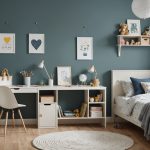Innovative Furniture Choices
In today’s fast-paced world, making the most of your space is more crucial than ever. Multifunctional furniture offers versatile solutions that cater to diverse needs, embodying a seamless blend of utility and style. Whether you live in a compact urban apartment or a stylish suburban home, space-saving designs can transform your living area into a more functional and aesthetically pleasing environment.
Consider investing in a sofa bed or a coffee table with hidden storage. These clever furniture solutions offer dual purposes, serving as comfortable seating during the day and easily transitioning into a bed or storage unit when needed. This approach not only optimizes your space but also adds an element of modern elegance.
A lire également : Essential Zoning Factors to Consider for Extending Your Detached Home in the UK
In the UK market, convertible desks that double as dining tables or folding chairs that tuck neatly away when not in use, are gaining popularity. These space-saving designs are ideal for small spaces, encouraging a lifestyle that values organisation and functionality.
A creative arrangement of such furniture can significantly enhance the flow and ambiance within your space. Thoughtfully placed items can define zones in an open-plan area, creating visual balance and guiding movement intuitively through your home.
Sujet a lire : Optimal Home Gym Design Ideas for Your UK Mid-Terrace House
Smart Storage Solutions
Envision a home that maximizes each inch with storage strategies destined to clear clutter effectively. Begin by exploring vertical spaces to unleash potential through shelves and wall-mounted storage, taking advantage of organizational hacks. By moving upward rather than outward, you free valuable floor space while maintaining accessibility. Consider adjustable shelving to adapt configurations as your storage needs evolve, offering a flexible solution tailored to dynamic environments.
Under-bed storage emerges as a lifesaver in space-constrained rooms, ideal for stashing seldom-used or seasonal items within easy reach. Opt for furniture with built-in compartments to further economize space, doubling the utility of every piece in your living area. Whether it’s a lift-top coffee table, ottoman with a hollow core, or a bed with drawers, such furniture blends functionality with style.
Adopting thoughtful decluttering tips can transform any room into a sanctuary of order. Start small by categorizing possessions, donating unwanted items, and employing clear containers to streamline visual chaos. Prioritize organization to establish a spacious feel, ensuring every item has its place, and every corner is neatly arranged. This fosters a tranquil environment, free from the anxiety of clutter.
Maximizing Floor Space
Maximizing floor space often begins with layout optimization, which can transform even the most compact areas into seemingly expansive environments. Integrating open-plan ideas into your home is a proven strategy. By reducing divisions and barriers, open-plan layouts allow for a free flow of natural light and air, creating a sense of spaciousness and connectivity between living areas.
Beyond the open-plan approach, room arrangements can optimize space without requiring structural modifications. Consider using versatile furniture that can perform multiple roles, such as a sofa bed or an extendable dining table. These solutions minimize clutter and maintain a clean, open aesthetic.
To further enhance your space, creative partition ideas can designate functional zones. Instead of erecting walls, use furniture pieces like bookshelves or freestanding screens to define areas. Floor rugs and lighting variations can also delineate different zones within a single room, promoting distinct functionalities without obstructing the overall openness.
These strategies not only improve the layout optimization but also preserve the flexibility and flow needed in modern living. By carefully arranging spaces and utilizing open-plan ideas, a balance between functionality and spaciousness can be achieved seamlessly.
Family-Friendly Design Techniques
Creating family-friendly spaces involves thoughtful planning to ensure both functionality and safety without sacrificing style. At the heart of this concept is the design of communal areas that naturally encourage family interaction. By integrating open floor plans, families can enjoy shared activities such as dining and entertaining together, enhancing the sense of togetherness.
When considering a kid-friendly design, it is crucial to strike a balance between space and safety. Safety features should be seamlessly incorporated, such as rounded furniture edges and non-slip flooring, safeguarding little adventurers while preserving aesthetic appeal.
Family spaces should be adaptable and flexible to accommodate the changing needs of growing children. For example, modular furniture can be reconfigured as the family evolves, making efficient use of every nook and cranny. Incorporating storage solutions not only keeps areas tidy but also ensures that toys and other items are always in reach, fostering independence among children.
Especially in urban environments where space might be limited, a clever layout that facilitates easy movement is key. Ultimately, designing with these principles in mind will create a harmonious home environment that caters to every family member’s needs and preferences.
Budget-Friendly Solutions
Finding economical space-saving options can be challenging, but there are numerous affordable alternatives to explore. Are you wondering how to make the most of your living space without breaking the bank? A great start is through cost-effective DIY projects that maximise available space.
Consider using wall-mounted shelves. These DIY projects not only save on floor space but also add a personal touch. Additionally, look into transforming old crates or pallets into unique, personalised storage solutions. This approach offers both functionality and a creative outlet.
When it comes to furniture, budget-friendly solutions abound. Look for economical space-saving treasures at thrift stores or community swap meets. Often, you’ll find versatile, foldable pieces that adapt to different uses and spaces, adding value without high costs.
Another excellent affordable alternative lies in community resources. Many cities offer recycling programs where you can find materials perfect for furniture-making or decor enhancement. It’s a sustainable choice that fosters creativity and resourcefulness.
Reimagining spaces through these methods not only benefits your budget but also sparks innovation. Embracing budget-friendly solutions can create a home that feels both spacious and personalised.
Real-Life Examples and Case Studies
Exploring case studies and real-life examples can illuminate the transformative power of practical applications. Consider the Smith family, who ingeniously reconfigured their small living area. By using multifunctional furniture and clever storage solutions, they converted a cramped room into a spacious, welcoming environment. Their journey exemplifies how thoughtful changes can optimize space effectively.
Practical applications can often be visualized through before-and-after transformations. For example, a once chaotic children’s room, cluttered with toys and clothes, was seamlessly organized by introducing vertical storage units and multi-use furnishings. Such visual aids highlight the dramatic impact of strategic planning in everyday settings.
Interviews with families delving into their space-maximizing adventures often provide invaluable insight. The Johnson family, for instance, shared that by employing dual-purpose furniture and decluttering, they not only expanded their living space but enhanced their lifestyle. Their testimony underscores the influence of functional design in daily life.
These case studies underscore the extensive benefits and tangible effects of practical applications. They illustrate how even small adjustments in interior settings can enhance both the functionality and aesthetic of a home.











